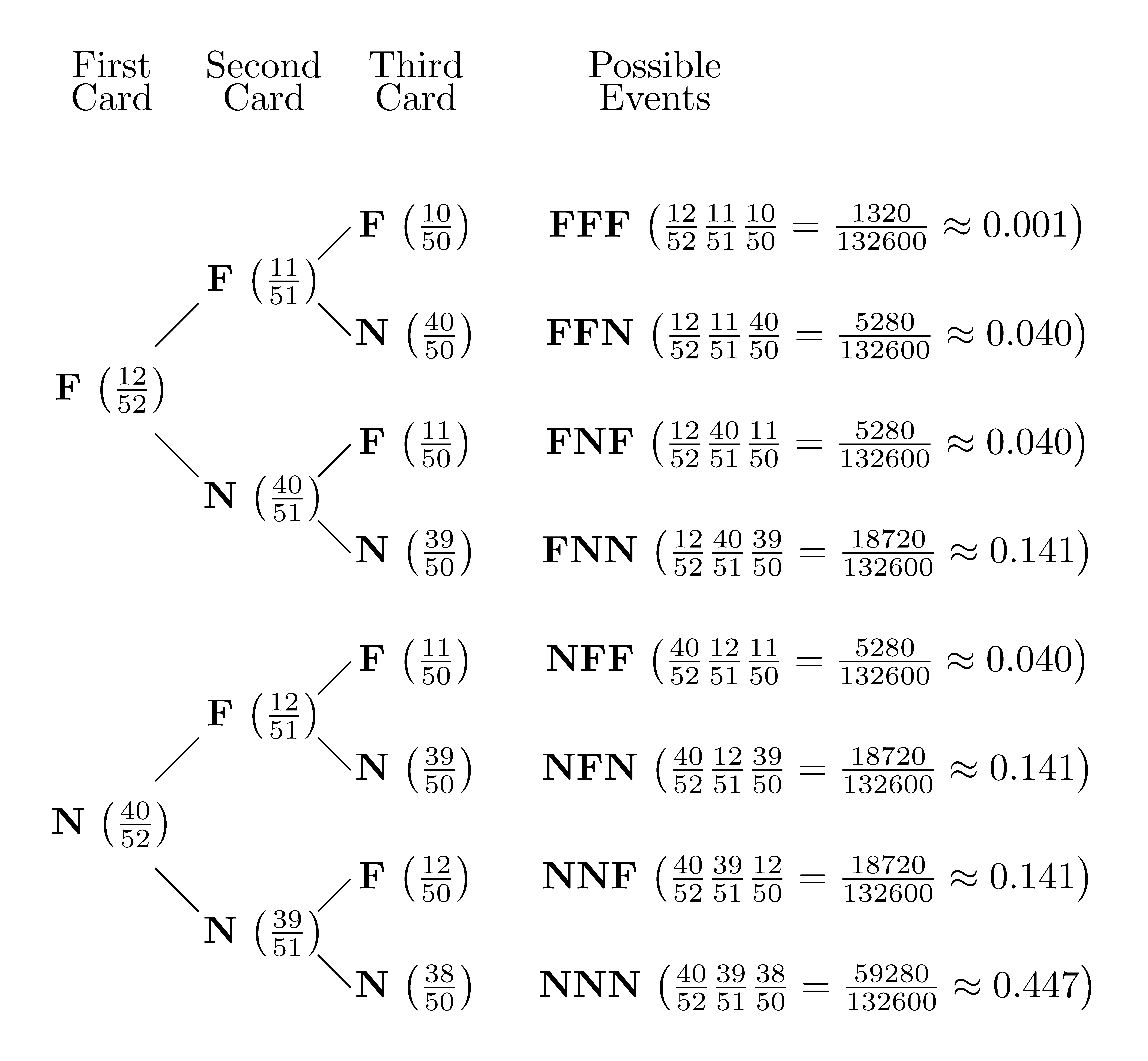16.3 Conditional Probability
There are times that we want to know the probability of a set of events conditioned on the occurrence of another set of events. For instance, if we are rolling two dice, we may want to know the probability that the sum of the dice is greater than 4 conditioned on the first die being a 2. With this scenario we have reduced the overall sample space to just those events for which the first die is a two. So what we are wanting to know is \[\frac{P(\mbox{sum of dice is greater than 4})}{P(\mbox{first die is a two})} = \frac{4}{6}\] since the total possible events are \(\{(2,1), (2,2), (2,3), (2,4), (2,5), (2,6)\}\) with only 4 of the 6 being the desired events.
Definition 16.4 If \(A,B\in \mathcal{F}\) then the conditional probability of \(A\) given \(B\) is defined as \[P(A\vert B) = \frac{P(A\cap B)}{P(B)} \mbox{, when } P(B)>0.\] Similarly, \[P(B\vert A) = \frac{P(A\cap B)}{P(A)} \mbox{, when } P(A)>0.\]
The assumption that \(P(B)>0\) for \(P(A\vert B)\) is reasonable in that if \(P(B)=0\), we would be assuming that an impossible event occurs.
Theorem 16.2 If \(A,B\in \mathcal{F}\), with \(P(A)>0\) and \(P(B)>0\), then \[P(A\cap B) = P(A)\cdot P(B\vert A) = P(B) \cdot P(A\vert B)\]
This theorem is demonstrated in the following tree.

Definition 16.5 Two events are independent if the occurrence of one does not affect the probability of occurrence of the other.
If two events are not independent, they are called dependent.
In terms of the probability measures, events \(A\) and \(B\) are independent if and only if \[P(A|B) = P(A) \quad \mbox{ and } \quad P(B|A) = P(B)\] since the probability of event \(A\) should be the same whether or not event \(B\) has occurred, similarly with \(B|A\). Combining this with the previous theorem we have the following theorem.
Theorem 16.3 Two events \(A\) and \(B\) are independent if and only if their joint probability equals the product of their probabilities. \[P(A \cap B) = P(A)P(B)\]
Proof. Assume that \(A\) and \(B\) are independent events. So \(P(A|B)=P(A)\). Combining this with Theorem 16.2 we have that \[P(A\cap B) = P(B)\cdot P(A|B) = P(B)\cdot P(A).\]
If we instead assume that \(P(A\cap B)=P(A)\cdot P(B)\), Theorem 16.2 implies that \[P(A)\cdot P(B) = P(A\cap B) = P(A) \cdot P(B|A) = P(B)\cdot P(A|B)\] and so we have \[P(B|A) = P(B) \mbox{ and } P(A|B)=P(A).\] So the events are independent.
Related Content Standards
- (HSS.CP.2) Understand that two events A and B are independent if the probability of A and B occurring together is the product of their probabilities, and use this characterization to determine if they are independent.
- (HSS.CP.3) Understand the conditional probability of A given B as P(A and B)/P(B), and interpret independence of A and B as saying that the conditional probability of A given B is the same as the probability of A, and the conditional probability of B given A is the same as the probability of B.
Let’s return to our example of drawing three cards and determining the probabilities of draw a face card or a number card.

Let \(A\) be the events where the first card drawn was a face card and \(B\) be the events where the third card drawn was a face card. So \[A = \{FFF, FFN, FNF, FNN\}\] and \[B=\{FFF, FNF, NFF, NNF\}.\] Since each of the events in \(A\) are mutually exclusive we have that \[\begin{align*} P(A) &= P(\{FFF\}) + P(\{FFN\}) + P(\{FNF\}) + P(\{FNN\}) \\ &= \frac{1320 + 5280 + 5280 + 18720}{132600} \\ &= \frac{17}{221} = \frac{3}{13}, \end{align*}\] \[\begin{align*} P(B) &= P(\{FFF\}) + P(\{FNF\}) + P(\{NFF\}) + P(\{NNF\}) \\ &= \frac{1320+5280+5280+18720}{132600} \\ &= \frac{17}{221} = \frac{3}{13}, \end{align*}\] and \[P(A\cap B) = P(\{FFF,FNF\}) = \frac{1320+5280}{132600}= \frac{11}{221}.\]
From these we have that \[P(A\vert B) = \frac{P(A\cap B)}{P(B)} = \frac{11}{17} \neq P(A)\] and \[P(B\vert A) = \frac{P(A\cap B)}{P(A)} = \frac{11}{17} \neq P(B)\] and so these are not independent events.
The non-independence of these events makes sense in this situation since the probability that the third card is a face card is dependent upon the first card being a face card as that would reduce the number of face cards that could be drawn later.
Because of the vagueness of the English language, individuals often are confused about the differences between independent and mutually exclusive events. Recall that two events, \(A\) and \(B\), are mutually exclusive if they cannot both occur at the same time, \(A\cap B=\emptyset\). This means that two events are mutually exclusive if \(P(A|B)=0\) and \(P(B|A)=0\).
Related Content Standards
- (HSS.CP.4) Construct and interpret two-way frequency tables of data when two categories are associated with each object being classified. Use the two-way table as a sample space to decide if events are independent and to approximate conditional probabilities.
- (HSS.CP.5) Recognize and explain the concepts of conditional probability and independence in everyday language and everyday situations.
We will now look at the math test scores for eighth graders in a local school district to determine if proficiency in math, as measured by the test, is dependent or independent of Gender and/or Race using some two-way frequency tables.
| Not Proficient | Proficient | Totals | |
|---|---|---|---|
| Male | 425 | 299 | 724 |
| Female | 362 | 295 | 657 |
| Totals | 787 | 594 | 1381 |
From this table we see that \(P(\mbox{Male})=\frac{724}{1381} \approx 0.524\), \(P(\mbox{Proficient}) = \frac{594}{1381} \approx 0.430\), and \[P(\mbox{Male and Proficient}) = \frac{299}{1381} \approx 0.217 .\] Since \[P(\mbox{Male})\cdot P(\mbox{Proficient}) \approx 0.524\cdot 0.430 \approx 0.225\] we see that it is very likely that proficiency on this math test is independent of gender as \(0.225\) is fairly close to \(0.217\).
These results can also be seen in the joint relative frequency table where independence is checked to see if the values inside the table match the product of the marginal probabilities.
| Not Proficient | Proficient | Totals | |
|---|---|---|---|
| Male | 0.308 | 0.217 | 0.524 |
| Female | 0.262 | 0.214 | 0.476 |
| Totals | 0.570 | 0.430 | 1.000 |
We now turn to a comparison of White and Black students in the same eighth grade math assessment with a two-way frequency table.
| Not Proficient | Proficient | Totals | |
|---|---|---|---|
| Black or African American | 324 | 107 | 431 |
| White | 388 | 465 | 853 |
| Totals | 712 | 572 | 1284 |
We now look at the joint relative frequency table to determine independence.
| Not Proficient | Proficient | Totals | |
|---|---|---|---|
| Black or African American | 0.252 | 0.083 | 0.336 |
| White | 0.302 | 0.362 | 0.664 |
| Totals | 0.555 | 0.445 | 1.000 |
Since \(P(\mbox{White}) \cdot P(\mbox{Proficient}) = 0.664 \cdot 0.445 = 0.296\) and \(P(\mbox{White and Proficient}) = 0.362\) we see that proficiency is not independent of race. Instead, we find \[P(\mbox{Proficient}|\mbox{White}) = \frac{P(\mbox{Proficient and White})}{P(\mbox{White})} \approx \frac{0.362}{0.664} \approx 0.545\] and \[P(\mbox{Proficient}|\mbox{Black}) = \frac{P(\mbox{Proficient and Black})}{P(\mbox{Black})} \approx \frac{0.083}{0.336} \approx 0.247\] which can be seen in the relative frequency table.
| Not Proficient | Proficient | Totals | |
|---|---|---|---|
| Black or African American | 0.752 | 0.248 | 1 |
| White | 0.455 | 0.545 | 1 |
Therefore, we can conclude that proficiency and race are not independent events. However, we can only assume from this information association claims, rather than causation.
Related Content Standards
- (HSS.CP.6) Find the conditional probability of A given B as the fraction of B’s outcomes that also belong to A, and interpret the answer in terms of the model.
- (HSS.CP.8) Apply the general Multiplication Rule in a uniform probability model, \(P(A \mbox{ and } B) = P(A)P(B|A) = P(B)P(A|B)\), and interpret the answer in terms of the model.